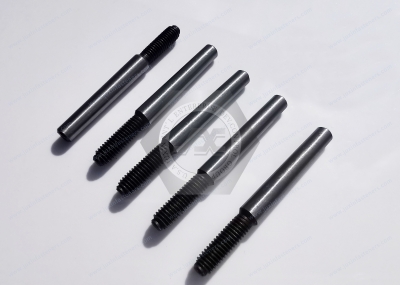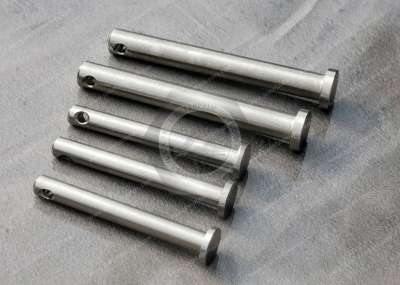Call Us
+86 136 6007 9809
Call Us
+86 136 6007 9809
Nov. 04, 2023
The inner threaded pin serves as a locating pin. The internal threaded hole serves to disassemble the pin by screwing in the screw and pulling out the pin. An internally threaded cylindrical pin is a mechanical connecting part with internal threads typically used to join two parts together. It is connected by inserting the threaded cylindrical pin into a hole and fastening it with threads. Internally, threaded cylindrical pins are critical in mechanical manufacturing and assembly.
Features of Female Cylindrical Pins
Unhardened female steel cylindrical pins are produced from ordinary steel as raw material. It has the following characteristics:
1. Cheap: Unhardened steel is used in most engineering, and its price is relatively low.
2. Easy to process: Unhardened steel has good workability, which makes it easy to process into various shapes and sizes of internal threaded cylindrical pins.
3. Moderate strength: Unhardened steel has good toughness and appropriate strength, suitable for some connection scenarios with small loads.
Definition and Standards for Female Cylindrical Pins
Cylindrical pins with internal threads are threaded fasteners used to connect two parts. They are characterized by the fact that the threads are located on the external surface of the pin. Cylindrical pins with female threads are subject to the standard DIN 7979, which specifies the technical requirements for dimensions, shapes, tolerances, and materials for cylindrical pins with female threads. In addition, female cylindrical pins also comply with international standards such as ISO8735, DIN7979, UNI6364B, and others.
Diameter tolerance of female threaded pins
According to DIN 7979, the diameter tolerance of internal cylindrical pins is divided into three grades, namely m6, m7, and m8. Take the example of an inner cylindrical pin with a diameter of Φ16; according to the tolerance grade of m6, the upper tolerance is 0.018, and the lower tolerance is 0.007. This means that the diameter of an internal cylindrical pin may fluctuate between the upper and lower tolerances during the production process to ensure the tightness and connecting performance of the threads. Tightness and connection performance. Flat-Vent Pull-Out Dowel Pins. The flat side of these pins relieves trapped air, making them easier to insert and remove from blind holes. One end is tapped, and the other is chamfered for easy insertion. To remove, thread a screw or tool into the tapped hole, then pull them out. Use them as pivots, hinges, shafts, jigs, and fixtures to locate or hold parts. Pins are precision ground for accurate alignment. Breaking strength is measured as double shear, the force required to break a pin into three pieces. Pins that meet ASME B18.8.2 specifications conform to ASME standards for material and dimensions.


Cylindrical pins with internal thread Material
a) C-pins: St=9SMnPb28 K according to DIN 1651.
b)D-pin: St=steel, tensile strength at least 600MPa, hardness HRC60±2
c)Other materials according to agreement
1. Austenitic stainless steel female cylindrical pin is a stainless steel material with the following characteristics:
Corrosion resistance: austenitic stainless steel has excellent corrosion resistance and can be used in harsh environments such as humidity, acid, and alkali.
Good toughness: Austenitic stainless steel is very tough and robust, which can meet the needs of some connections with high loads.
Good high-temperature performance: Austenitic stainless steel can still maintain good performance in high-temperature environments, which makes it suitable for some special working conditions of the connection.
2. When choosing unhardened steel or austenitic stainless steel female cylindrical pins, the following factors need to be considered:
Use of the environment: if it is used in humid, acid-alkali, and other corrosive environments, austenitic stainless steel female cylindrical pins should be selected.
Load requirements: If the connection needs to withstand a higher force or load, an austenitic stainless steel female cylindrical pin should be chosen because it is more robust.
Economy: If the economy is the primary consideration and environmental and load requirements are low, an unhardened steel female clevis pin may be selected.
Slotted spring pins, also known as roll, tension, split, and expansion pins, have a slot along one side that you squeeze closed to install into unthreaded holes. Once established, they expand slightly, creating outward tension that holds them tight against the whole wall. These pins absorb shock and vibration in your system and keep parts from loosening. They are often used as hinge pins or to hold springs and power transmission components in place.
Install these pins into a hole. They have at least one chamfered end, which is angled to make insertion easier.
Breaking strength is measured as double shear, the force required to break a pin into three pieces.
Some metric pins with the same diameter come in two different wall thicknesses. Thinner walls are more flexible, easier to install, and won’t weigh down your assembly as much as thicker pins. Layer a pin with a light wall inside a thicker one to increase the breaking strength. Make sure the slots are opposite one another for maximum strength.
Steel pins are solid and wear-resistant. Pins with a black-phosphate or zinc-plated finish have an outer layer to protect the steel underneath from rust.
18-8 stainless steel pins balance strength and corrosion resistance.
Three hundred sixteen stainless steel pins have the best corrosion resistance of our stainless steel pins and are as strong as 18-8 stainless steel pins.
400 series stainless steel pins resist wear from abrasion and have some corrosion resistance.
Four hundred twenty stainless steel pins are as solid and wear-resistant as steel, with the addition of corrosion resistance in wet environments.
Passivated pins offer added protection against corrosion and oxidation.
Pins that meet ASME B18.8.2 specifications are made to ASME standards for material and dimensions.
Pins that meet MS16562 conform to military standards for material and dimensions.
Pins that meet specifications for ISO 8752 (formerly DIN 1481) or ISO 13337 (formerly DIN 7346) adhere to international standards for pin dimensions.
Application Scenarios of Cylindrical Pins with Female Thread
Cylindrical pins with internal threads are widely used to connect and fix various mechanical equipment, such as automobiles, motorcycles, bicycles, machine tools, electrical appliances, etc. Its primary function is to connect two parts firmly and simultaneously have a particular ability to adjust and bear torque. Female cylindrical pins should be selected based on application scenarios and design requirements, considering size, material, and tolerance factors. In conclusion, as a standard threaded fastener, female cylindrical pins have a wide range of applications in machinery manufacturing.
How to properly use and install a female cylindrical pin?
Properly use and installation of female cylindrical pins are critical to ensure the performance and stability of the connection. The following are the appropriate use and installation methods:
1. Ensure that the dimensions and specifications of the female lynchpin match the connection hole.
2. Clean the connection hole and female pin surfaces before installation.
3. Use the correct tool to insert the female cylindrical pin into the connection hole and ensure it is fully inserted.
4. Use the appropriate torque tool to tighten the female pin.
5. Regularly check the connection for looseness and perform maintenance and servicing as required.
If you are looking for high-quality automotive fastener screws & all kinds of plastic fasteners or technical support for structural design, please get in touch with me. Use our new Product Finder tool, download our Product Catalog, and let us help you get custom parts.adelajonly@gmail.com. Thanks. Website: www.juxinfasteners.com
Contact Us
Tel.:
+86 020 8621 0320
+86 020 3121 6067
Technical Support:
Navigation
SEND INQUIREY